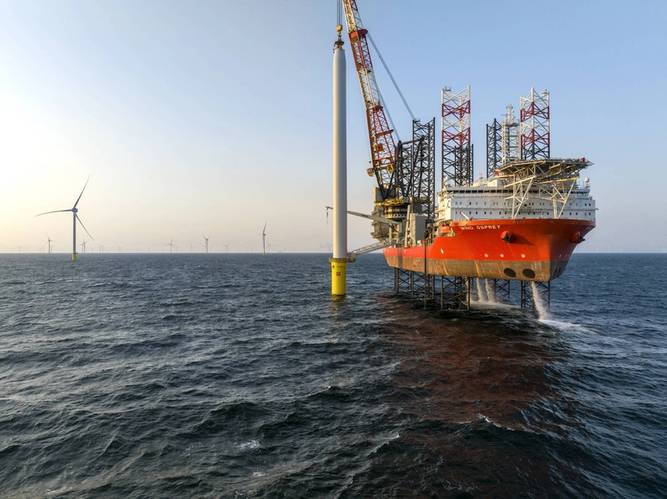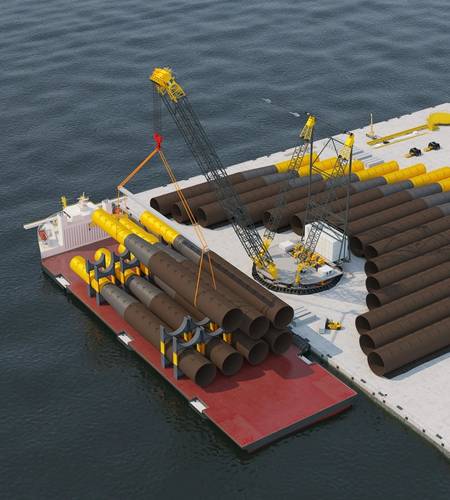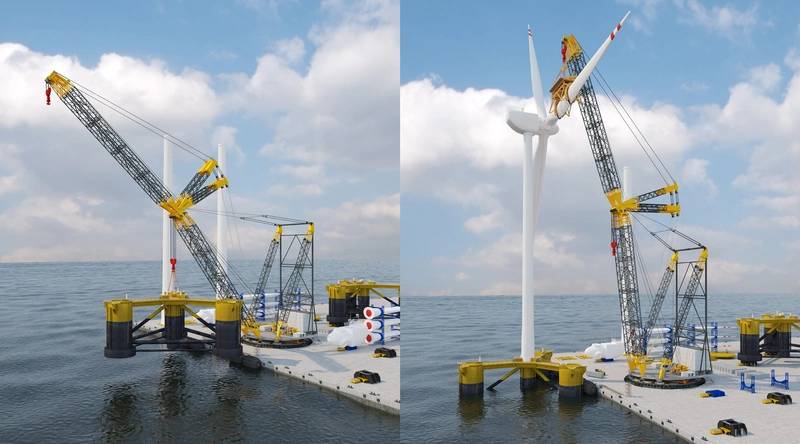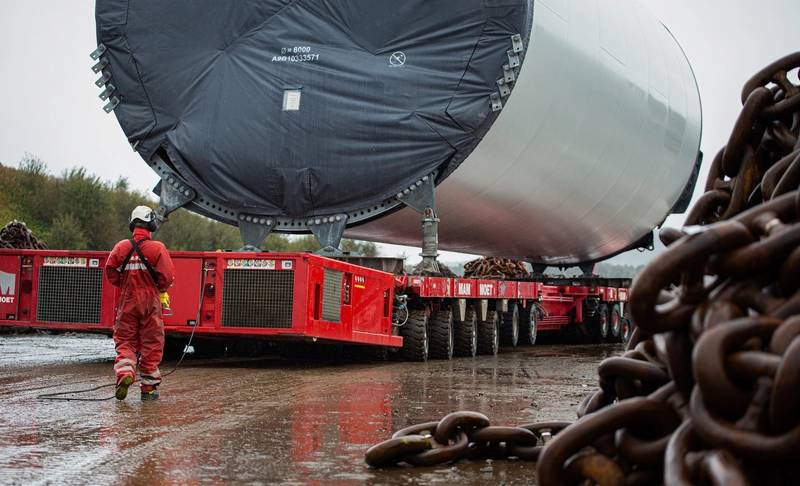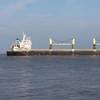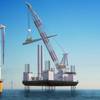New Cranes & Offshore Wind Efficiency
The end may be in sight, but the race for bigger cranes is still having an impact on offshore wind project efficiency.
The industry has already felt the need for upgrading crane lifting capacity on existing offshore wind installation vessels: NOV is upgrading the cranes on Cadeler’s existing O-class wind turbine installation vessels (WTIVs), and a gantry crane extension will soon make Van Oord’s Svanen one of the largest floating heavy-lift installation vessels.
It’s a newbuild phenomenon too.
NOV has developed a telescoping leg encircling crane for Shimizu’s GustoMSC-designed WTIV Blue Wind. When deployed in a retracted mode, the crane has a safe working load of 2,500t with a lifting height of 118m above the deck. The crane can then easily transition to an extended mode to install turbines at a height of up to 158m with a maximum safe working load of 1,250t. This means it is suitable for installing both foundations and towers.
Cadeler's new NG-20000X class vessels will have 2,600t cranes, and its new NG-20000F class vessel will have a 3,200t crane. Similar new vessels for Havfram will have a crane of approximately 3,200t, as will Van Oord's KNUD E. HANSEN-designed newbuilding currently being built in China.
Details of this vessel’s lifting capacity are yet to be made public, but Jesper Kanstrup, Senior Naval Architect at KNUD E. HANSEN, says these big cranes and vessels are needed to meet the installation challenges of scaling up of turbine capacity to 20MW. The towers could easily weigh over 1,500t, nacelles over 1,000t and blades over 100t.
Designing new vessels involves predicting what turbine components will weigh 25 years into the future, and Kanstrup is already looking towards a future that could include 25MW+ turbines. Then, towers could weigh at least 2,500t.
“A reason for even larger cranes would not only be the desire to be able to install 25MW turbine towers in one piece but also to expand the area on the deck within which the crane can handle the heavy towers or nacelles and thereby be able to carry more turbines on the vessel,” says Kanstrup. “If, for example, a 3,200t crane can handle a load of 2,000t within a radius of 55m, a 4,000t crane might be able to handle the same load within a radius of maybe 68m. So, the desire to be able to carry more turbines on the vessel could very well be the driving factor for even larger cranes.”
Competition between turbine manufacturers is so tough that the turbines have barely been thoroughly tested before they are launched on the market, says Kanstrup, and too few of each size will be manufactured to pay for the development costs before an even larger size is required. “And if the manufacturers are bleeding, that could eventually put a damper on the size race.”
For Elomatic, that race is already over, at least for the heavy lift vessels that install foundations. The company’s Float Foundation, suitable for fixed turbines in water depths of up to 45 meters, can be built at a shipyard or dock, and it only needs two tugboats, and no offshore lifts, for installation.
There’s a second crane race underway, though, this time onshore where components are stored and assembled ready for offshore installation. Large ring cranes can optimize the use of high-value offshore installation vessels by assembling the turbines efficiently, even as offshore wind components continue to grow in size.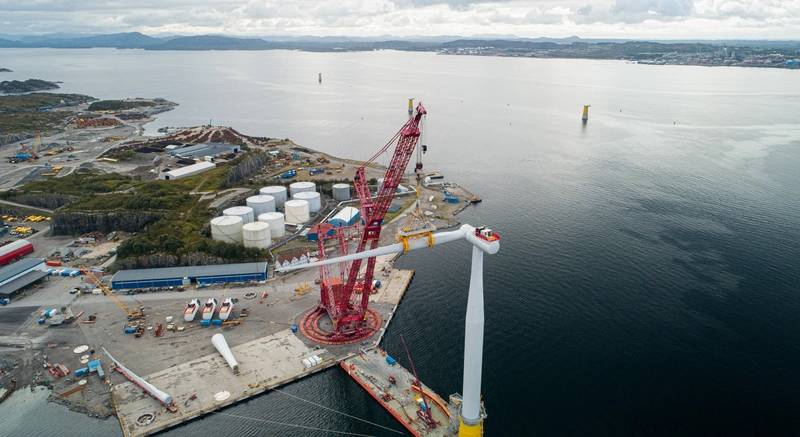 Mammoet’s PTC200 crane assembling a floating wind turbine blade. Image courtesy of Mammoet.
Mammoet’s PTC200 crane assembling a floating wind turbine blade. Image courtesy of Mammoet.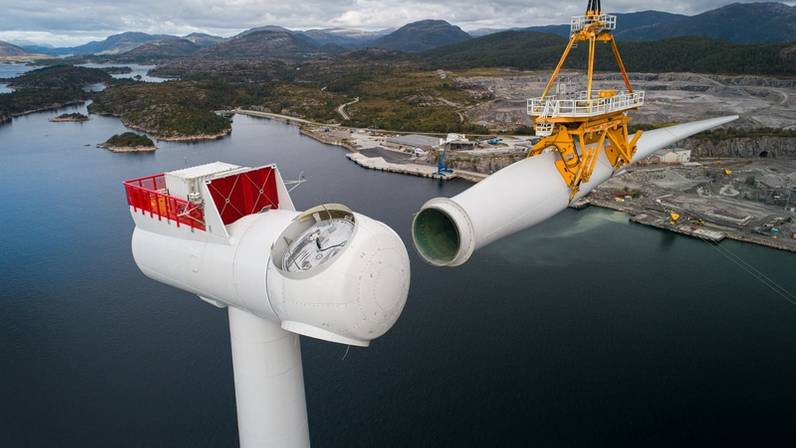 A closeup of a blade installation process taken via drone. A blade handling system is apparent (in yellow). Image courtesy of Mammoet.
A closeup of a blade installation process taken via drone. A blade handling system is apparent (in yellow). Image courtesy of Mammoet.
On Equinor’s Hywind Tampen project, the largest floating wind project to date, Mammoet provided its PTC200-DS ring crane quayside to handle the 134m distance that turbine components needed to be lifted over the quay edge, over a spacer barge, then on to the 107m spar buoy foundations for assembly. The crane eliminated the need for the more complex engineering that would have been required if the components were transferred by crane between two floating vessels.
Heavy Lift Projects (HLP) is developing what it claims is the world’s biggest ring crane, one capable of 6,000t lifts. “It's an ambitious outlay for us, but we think that there's a market requirement for the development of these cranes, particularly in floating offshore wind,” says Adrian Green, Engineering & Contracts Director. “Ports are a major bottleneck at the moment, certainly in Western Europe.”
The crane will have two hooks, one on the main boom and then a second on a luffing jib. This reduces the time it would ordinarily take, weeks, to reconfigure the wiring of an ordinary crane. “Effectively, it can move the foundation in one lift and then immediately pick up the tower.”
The crane will also enable components such as towers to be stacked vertically in marshalling areas, reducing their footprint from around 150m long and 7m wide to just that of the diameter of the base. It also enables them to be moved without SPMTs. Additionally, in fixed foundation wind, monopiles can be stacked in multiple layers for delivery to the marshalling area. This would result in a major time and fuel saving. For floating projects, it could reduce project installation time enough to make it comparable to fixed wind, says Green.
The development of the floating wind industry will be different to that of fixed wind. The subsidies won’t be a plentiful, and there won’t be the same downturn in oil and gas that made all the high-spec construction vessels available at attractive rates, says David Inman, Sales Manager at NOV-subsidiary GustoMSC. “The industry needs assets specifically designed for what is going to be a very industrialized installation campaign.”
NOV has launched the Enhydra floating wind installation vessel (FWIV) concept for the global market which is expected to scale up significantly between 2028 and 2035. The GustoMSC-designed vessel has a 400t main crane featuring NOV's knuckle boom design which features integrated heave compensation in a fully electric and closed-loop hydraulic setup, eliminating the need for a separate motion-compensated crane.
The vessel design is optimized for both mooring and hook-up operations and offers a flexible deck layout and specific provisions for mission equipment integration, including electric subsea cranes. Electrification enhances operational smoothness and reduces downtime.
Inman sees strong market potential for the FWIV. “Floating offshore wind is going to be a global industry, and it's going to be big from the get go.”
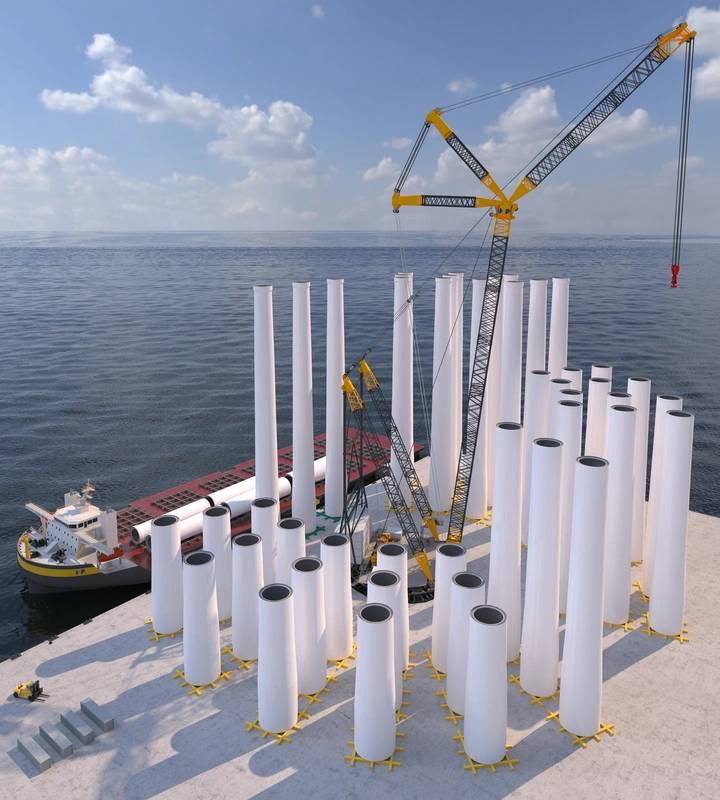 HLP is developing a crane that will enable components such as towers to be stacked vertically in marshalling areas. Image courtesy of HLP.
HLP is developing a crane that will enable components such as towers to be stacked vertically in marshalling areas. Image courtesy of HLP.









